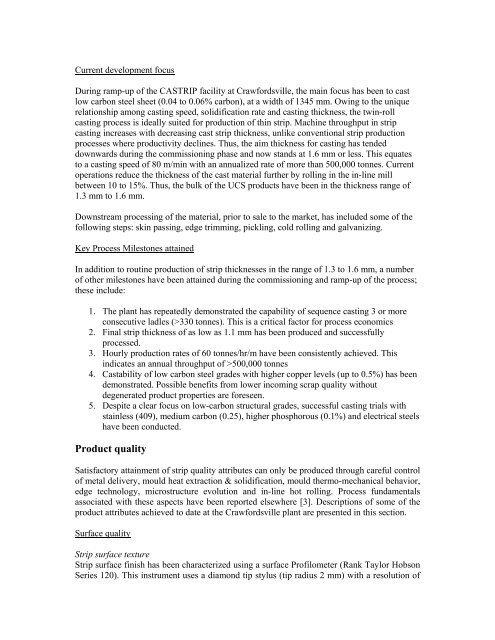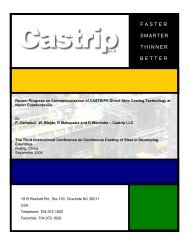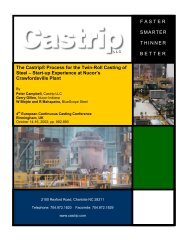The Status of Twin-Roll Strip Casting Technology - Castrip
The Status of Twin-Roll Strip Casting Technology - Castrip
The Status of Twin-Roll Strip Casting Technology - Castrip
Create successful ePaper yourself
Turn your PDF publications into a flip-book with our unique Google optimized e-Paper software.
Current development focus<br />
During ramp-up <strong>of</strong> the CASTRIP facility at Crawfordsville, the main focus has been to cast<br />
low carbon steel sheet (0.04 to 0.06% carbon), at a width <strong>of</strong> 1345 mm. Owing to the unique<br />
relationship among casting speed, solidification rate and casting thickness, the twin-roll<br />
casting process is ideally suited for production <strong>of</strong> thin strip. Machine throughput in strip<br />
casting increases with decreasing cast strip thickness, unlike conventional strip production<br />
processes where productivity declines. Thus, the aim thickness for casting has tended<br />
downwards during the commissioning phase and now stands at 1.6 mm or less. This equates<br />
to a casting speed <strong>of</strong> 80 m/min with an annualized rate <strong>of</strong> more than 500,000 tonnes. Current<br />
operations reduce the thickness <strong>of</strong> the cast material further by rolling in the in-line mill<br />
between 10 to 15%. Thus, the bulk <strong>of</strong> the UCS products have been in the thickness range <strong>of</strong><br />
1.3 mm to 1.6 mm.<br />
Downstream processing <strong>of</strong> the material, prior to sale to the market, has included some <strong>of</strong> the<br />
following steps: skin passing, edge trimming, pickling, cold rolling and galvanizing.<br />
Key Process Milestones attained<br />
In addition to routine production <strong>of</strong> strip thicknesses in the range <strong>of</strong> 1.3 to 1.6 mm, a number<br />
<strong>of</strong> other milestones have been attained during the commissioning and ramp-up <strong>of</strong> the process;<br />
these include:<br />
1. <strong>The</strong> plant has repeatedly demonstrated the capability <strong>of</strong> sequence casting 3 or more<br />
consecutive ladles (>330 tonnes). This is a critical factor for process economics<br />
2. Final strip thickness <strong>of</strong> as low as 1.1 mm has been produced and successfully<br />
processed.<br />
3. Hourly production rates <strong>of</strong> 60 tonnes/hr/m have been consistently achieved. This<br />
indicates an annual throughput <strong>of</strong> >500,000 tonnes<br />
4. Castability <strong>of</strong> low carbon steel grades with higher copper levels (up to 0.5%) has been<br />
demonstrated. Possible benefits from lower incoming scrap quality without<br />
degenerated product properties are foreseen.<br />
5. Despite a clear focus on low-carbon structural grades, successful casting trials with<br />
stainless (409), medium carbon (0.25), higher phosphorous (0.1%) and electrical steels<br />
have been conducted.<br />
Product quality<br />
Satisfactory attainment <strong>of</strong> strip quality attributes can only be produced through careful control<br />
<strong>of</strong> metal delivery, mould heat extraction & solidification, mould thermo-mechanical behavior,<br />
edge technology, microstructure evolution and in-line hot rolling. Process fundamentals<br />
associated with these aspects have been reported elsewhere [3]. Descriptions <strong>of</strong> some <strong>of</strong> the<br />
product attributes achieved to date at the Crawfordsville plant are presented in this section.<br />
Surface quality<br />
<strong>Strip</strong> surface texture<br />
<strong>Strip</strong> surface finish has been characterized using a surface Pr<strong>of</strong>ilometer (Rank Taylor Hobson<br />
Series 120). This instrument uses a diamond tip stylus (tip radius 2 mm) with a resolution <strong>of</strong>





